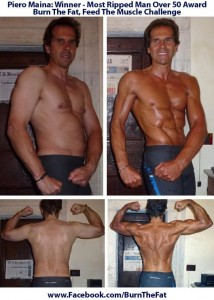Title: Tom Venuto’s Holiday Fitness Challenge to You
By line: By Tom Venuto
URL: www.BurnTheFat.com
Word count: 2066 words
Tom Venuto’s Holiday Fitness Challenge to You
By Tom Venuto, NSCA-CPT, CSCS www.BurnTheFat.com
Every year as Thanksgiving gets closer, you’ve probably seen the depressing reports: “Most people gain between 5 and 10 pounds of body fat in the six weeks between Thanksgiving and Christmas.” I’m not sure if this worries you or not, but a lot of people are terrified about getting fatter in the next two months. They anticipate the workouts falling by the wayside and the holiday food calling out to them irresistibly, defeating even the strongest willpower. There’s good news and bad news about this.
Good news: According to the New England Journal of Medicine, the average amount gained is much more modest – just over a pound.
Bad news: A study by the National Institutes of Health found that this seasonal weight gain – even just a pound – is the kind of weight gain that most people don’t lose when the holidays are over; it simply adds to the “weight creep” that “sneaks up” on you as you get older.
People often wonder how it’s possible to wake up one morning at age 40 or 45 and “suddenly” they’re 30 pounds fatter – or more – than they were in college. Mystery solved.
Of course, some people really do pack it on over the holidays, but whether its a pound or ten pounds, did you ever ask yourself why does holiday weight gain happen at all?
In previous years, I’ve asked my readers and here are some common answers I was given:
Holiday Excuse Survey Says…
“I’m too busy over the holidays to work out as often as usual.”
“I’m more stressed over the holidays, and the food is there, so I eat more.”
“I have at least three parties to attend and then there’s Christmas and New Year’s, so it’s impossible to stay on a diet”
“No one can tell me not to enjoy myself over the holidays so I’m just going to eat whatever I want.”
These answers all have a few things in common:
“Either/Or” Thinking and “Reverse Goal Setting” Exposed
First, they assume that you can EITHER get in better shape OR enjoy yourself, but not both. Stated in reverse: You can either deprive yourself of holiday enjoyments or gain weight, but it has to be one or the other. The truth is, “either/or thinking” is neurotic thinking and a great killer of fitness programs.
Second, these are all excuses or rationalizations. “I’m too busy” for example, is always an excuse, because I have never known someone who was too busy to make time for his her highest life priorities. We all have the same amount of time – 24 hours a day – the real problem is, most people don’t make exercise and healthy eating a priority. And remember, words mean little. Actions reveal a person’s true priorities.
Third, none of these are the real reasons most people gain weight over the holidays to begin with. The real reason is because an intention was never set for the opposite: To get in better shape over the holidays.
Most people set a “goal” to get in worse shape over the holidays. It’s not consciously set, of course, as few people would intentionally set out to get fatter. They simply do it by default. In their minds, they accept that it must be just about impossible to stay in shape with everything going on over the holiday season, so why bother?
Rationing Lies For Holiday Failure
Once the decision has been made, then the rationalizing continues:
“Why should I deprive myself?” “Family is more important” “Worrying about diet and exercise during the holidays is neurotic” “I don’t care if I gain a few pounds, I’m going to enjoy myself anyway” “It’s only these two or three weeks that I let myself go wild” “I’ll start the first week in January and lose the weight then.”
As a result of this “negative goal-setting,” they expect to work out less, eat more and gain a few pounds, and they don’t seem to even consider alternatives.
But what would happen if you…
SET A GOAL TO GET IN BETTER shape over the holidays?
What would happen if you decided that it was not an all or nothing proposition and that you could enjoy the holidays and all it has to offer and get in better shape at the same time?
And what if you decided that your health and your body were the highest priorities in your life, because you realized that can’t enjoy anything else in life, including family or holidays, if you don’t have your health?
Here’s what would happen: You’d get in better shape!
I’m not all that different from you just because I’m a bodybuilder and fitness professional. I have many of the same problems, concerns and struggles as you do. Although today I always get in better shape between Thanksgiving and New Year’s, that’s a result of a conscious choice, a close examination of my old belief systems and a lot of action. For me, it all started about eight years ago.
For most of my adult life, I wasn’t much of a traveler and I didn’t enjoy flying or staying in hotels. For one thing, I had so many business commitments in the East Coast health club business, that I seldom left town for long, as I had to “tend to the stores.” But I also had a belief that if I traveled, my workouts and nutrition would suffer. After all, “it would be hard to stick with my usual bodybuilding diet, and I wouldn’t have access to my usual gyms”, I told myself. For these reasons, I never did much travel..
Then I was forced to take some trips for business reasons. Predictably enough, my nutrition and workouts suffered while I was spending time in airplanes and in hotels. With my experience having confirmed my beliefs, I re-affirmed to myself, “See, travelling is nothing but a pain. You just can’t stay on a diet and training program when you’re out of town.”
After several more trips, I noticed that something very negative happened: I surrendered. I had resigned myself to “not bother” while I was on the road. I let my expectations create my reality.
But I didn’t let it go on for long. As soon as I became aware of what was happening, I decided that I wouldn’t tolerate it, so I challenged myself and my previous limiting beliefs. I asked myself, “Why the heck not? Why let myself backslide? Why even settle for maintaining? Why not challenge myself to improve while I’m traveling?” The answer was: There was no good reason, there were only excuses.
From that day forward, I set a challenge for myself…
To come back from every trip or vacation in better shape than when I left.
Of course there were exceptions, as when I went on a vacation for total R & R. But I never let travel get in my way again. I prepared food that I would eat on the planes so airline food was never an excuse… I usually chose hotels that had kitchens, so I could cook my own food. I went food shopping immediately after check-in. I wrote my training schedule and scouted gyms in advance… And I actually found myself training harder than usual.
No matter where I was training – it could even be some “dungeon” of a gym in the middle of nowhere – it didn’t matter because my mind was focused on improving and looking better when I came home than when I left. I had a goal to motivate me!
What do you think happened? It’s not hard to guess: I always came home in better shape than when I left.
Since then, my “travel challenge” has become somewhat of a ritual in my life. When I’m away from my “home-base” it becomes a “fitness road trip.” I search the Internet or yellow pages or ask locals to help me find the most hard-core gym nearby wherever I will be staying (Gold’s Gym works for me!) When I get there, I train every bit as hard as if I had a competition just weeks away. I look forward to it now. In fact, this is what led me to my “holiday fitness challenge” idea.
Like many people, I travel over the holidays, so I’m automatically in “travel challenge” mode at thanksgiving, Christmastime and New Year’s. But with the additional temptations and busyness that the holidays bring on top of the usual travel stresses, I saw fit to declare a new challenge: “The Holiday Challenge.” The difference was that for my “holiday challenge,” I pledged to not only to return home in better shape than when I left, but to enjoy the holidays to the fullest at the same time.

People who think I deprive myself to look the way I do would be shocked: I eat like a KING over the holidays including Pumpkin (or apple) Pie at Thanksgiving and OF COURSE my mom’s famous red and green Jell-O Christmas cake. Then on New Year’s I’m usually toasting champagne and having a blast with friends or family….
The difference is, I don’t eat like that very often.
Every other meal stays right on schedule and I work out hard and consistently over the holidays; I don’t let everything fall apart just because ‘tis the season.’
The idea that you can EITHER enjoy the holidays OR stay in shape – but not both – is wrong, it’s damaging and it’s limiting.
Life is not an either or proposition; it’s a matter of balance.
Success does not mean going to extremes. Success can be a simple matter of re-examining your beliefs, rearranging your priorities, setting goals, changing the questions you ask yourself and re-evaluating your expectations.
Your expectations will become your reality. What are you expecting? Are you expecting success? Are you expecting to be in better shape after holiday parties, celebrations, banquets, dinners, and desserts? If not, then why not? What’s preventing you from enjoying all of the above and still getting in better shape? Do you have a limiting belief which dictates that it’s one or the other? Could it be that you never set a goal, intention or expectation to do it? Could it be that you’re rationalizing or making excuses? If so, then I challenge you to change it this year.
As of this writing, there are less than two months until the end of the year. Why not see how much you can improve your physique over the holidays, without depriving yourself of any holiday enjoyments or festivities? Just step up your expectations. Step up your standards. Step up your nutrition. Step up your training. Step up your action. Step up and accept the “Burn The Fat holiday fitness challengeand see what happens!
That’s right… The First Annual Burn The Fat Holiday Fitness challenge contest is open from Wednesday November 18th to Wednesday November 25th.
Over the course of a “50-Day Burn” which spans all three major holidays – Thanksgiving (US), Christmas and New Year’s – you’ll have the motivation, the accountability and structured program to end the year strong, start the new year on the foot and possibly get in the best shape of your life.
Even better, you’ll be able to eat delicious Holiday Food and enjoy yourself to the fullest at the same time because this is a lifestyle program which allows your favorite foods in moderation and balance.
And the best part of all: I’m sending the winners of the contest to Hawaii islands to show off their new bodies on the beach in 2013!
Taking the Burn The Fat Challenge is simple. You can enter the contest two ways:
(1) Purchase the Burn The Fat e-book from www.BurnTheFat.com! or
(2) Join the Burn The Fat Inner Circle fitness support community (“contest central”) at http://www.BurnTheFatInnerCircle.com.
You’ll be automatically enrolled with either purchase.
Train hard and expect success!
-Tom Venuto, Author of Burn The Fat, Feed The Muscle Founder/CEO, Burn The Fat Inner Circle
About the author:
Tom Venuto is a natural bodybuilder, certified personal trainer and freelance fitness
writer. Tom is the author of “Burn the Fat, Feed The
Muscle,” which teaches you how to get lean without
drugs or supplements using secrets of the world’s best
bodybuilders and fitness models. Learn how to get rid of
stubborn fat and increase your metabolism by visiting:



















